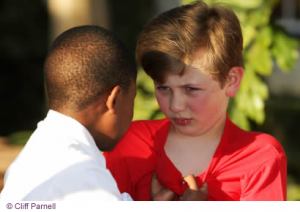A University of Queensland study has found that females who experience early puberty have increased levels of aggression.
The report, recently published in the Australian and New Zealand Journal of Criminology, also found that the aggression/delinquency self reported by females is comparable to the rate of young males.
The research is believed to be the first population-based study that has linked the age of puberty with increased rates of antisocial behaviour and to suggest that young females may behave as aggressively as males.
The paper lead author is the Director of the UQ Queensland Alcohol and Drug Research and Education Centre, and School of Population Health sociologist Professor Jake Najman.
Professor Najman and his co-researchers suggest that females who experience early puberty (before the age of 12) may have disrupted social networks, increased parental conflict and different desires and expectations to their peers.
Although males and females undergo different hormonal changes during puberty, the findings suggest that both genders experience increased levels of aggression as they progress through puberty.
Professor Najman said there was evidence of a diminishing gap between male and female health risk behaviours.
“Females are as willing as males to engage in types of aggressive or delinquent behaviours,” he said.
“This shows that there may simply be a greater acceptance of these behaviours in females than has previously been the case.”
This finding was supported by the Australian Institute of Health and Welfare, who showed that young females now smoke at rates equal to or higher than males, binge drank alcohol at similar rates, and were closing the gap in the use of some illicit drugs.
“While some researchers argue for early childhood intervention, we suggest that early puberty and adolescence is an appropriate time to initiate programs,” he said.
“There is a possibility that the rates of aggression observed in females may lead to more substantial offending behaviour as these females mature.”
The data is derived from the Mater University Study of Pregnancy and its outcomes, Australia’s largest longitudinal study which has tracked over 8000 mothers and their children over a 21 year period (and a 30 year follow-up to be conducted).
Study co-authors are Reza Hayatbakhsh, Tara R. McGee, William Bor, Michael J. O’Callaghan and Gail M. Williams.
Source: University of Queensland
 The act and victimization of bullying continues to be a problem among today’s youth. While many children are experiencing this form of violence, it is more prevalent in children that are different from the social norm. As medical professionals continue to further their understanding of bullying, research shows a high rate of sexual minority youth who experience this harmful activity.
The act and victimization of bullying continues to be a problem among today’s youth. While many children are experiencing this form of violence, it is more prevalent in children that are different from the social norm. As medical professionals continue to further their understanding of bullying, research shows a high rate of sexual minority youth who experience this harmful activity.

